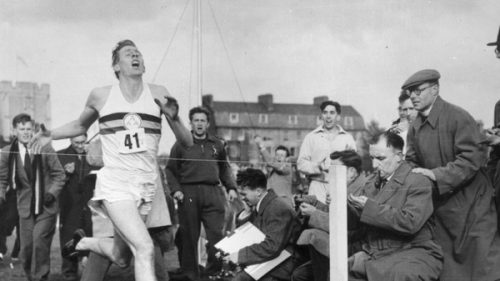
By Ivan Agnew
A world athletics giant has passed away with the recent death of Sir Roger Bannister at the age of 88.
The tall, lanky doctor with the long loping stride sprinted away from pacemakers Chris Chataway and Chris Brasher to achieve what was deemed an impossible sub 4 minute mile at Oxford in 3m 59.4s on May 6, 1954.
Up until then in had been a battle between the Englishman and gentlemanly Australian John Landy to become the first to do so.
In one attempt by Landy in Australia, he blew his chance by stopping to pick up a fallen opponent but later reduced Bannister’s record to 3m 58s.
That was the era of our own New Zealand hero Murray Halberg whose favourite distance was the mile before he won Olympic gold over 5000m at the 1960 Rome Olympics shortly before Peter Snell struck gold over 800m.
Bannister never won an Olympic medal. But his 1954 British Commonwealth 1500m win over Landy in Vancouver was a classic when he swept past the Aussie’s right shoulder the moment Landy looked for him on his left.
With Jack Lovelock (Berlin 1939), Snell (Tokyo 1964) and John Walker (Montreal 1976) becoming Olympics champions over 1500m, it was not surprising all three New Zealanders would break world mile records.
Snell broke the unbeaten Australian Herb Elliott’s 3m 54.5s by 0.1s at Wanganui’s Cook Gardens on January 27, 1962, and reduced it further to 3m 54.04s in Auckland on November 16, 1964.
There was never any doubt that Tanzania’s Filbert Bayi and John Walker would be the male middle distance stars of the mid 1970s when they both broke American Jim Ryun’s world 1500m record at the 1974 Christchurch Commonwealth with gutsy front runner Bayi striking gold.
With Bayi clocking a world record 3m 51s mile at Kingston, Jamaica, on May 17,1975, the race to become history’s first sub 3m 50s miler was on, just as it had been before Bannister cracked the 4m barrier 21 years earlier.
It was Walker who did it that same year when running the last two laps solo to blitz the field at Gothenburg, Sweden, when I held his stop watch and called him the lap times.
“How fast?” he asked when I ran across to him and showed him the stop watch in my shaking hand after he had finished.
‘Under 3 minutes 50 seconds,” I shouted.
“Oh, my God?” he cried, clutching his head before throwing his arms in the air in ecstasy.
That race and his 3m 49.4s (10s faster than Bannister) provided the highlight chapter of my second book, Kiwis Can Fly.
Walker’s time lasted almost four years before Sebastian Coe (3m 49s) lowered it on the fast Oslo, Norway, track in 1979.
Coe lowered it further to 3m 48.53s and 3m 47.33s and in between Steve Ovett held the record at 3m 48.40s. But Steve Cram surpassed his fellow Englishmen when he ran a blistering 3m 46.32s at Oslo in 1985.
That was 10 years after Walker, who was to become the first to run 100 sub 4-minute miles and the first 40-year-old to break a barrier Bannister had proved possible.
Today the record stands at an amazing 3m 43.13s. set in Rome by El Guerrouj of Morocco on July 7, 1999.
- Ivan Agnew is an award-winning sports writer and author








